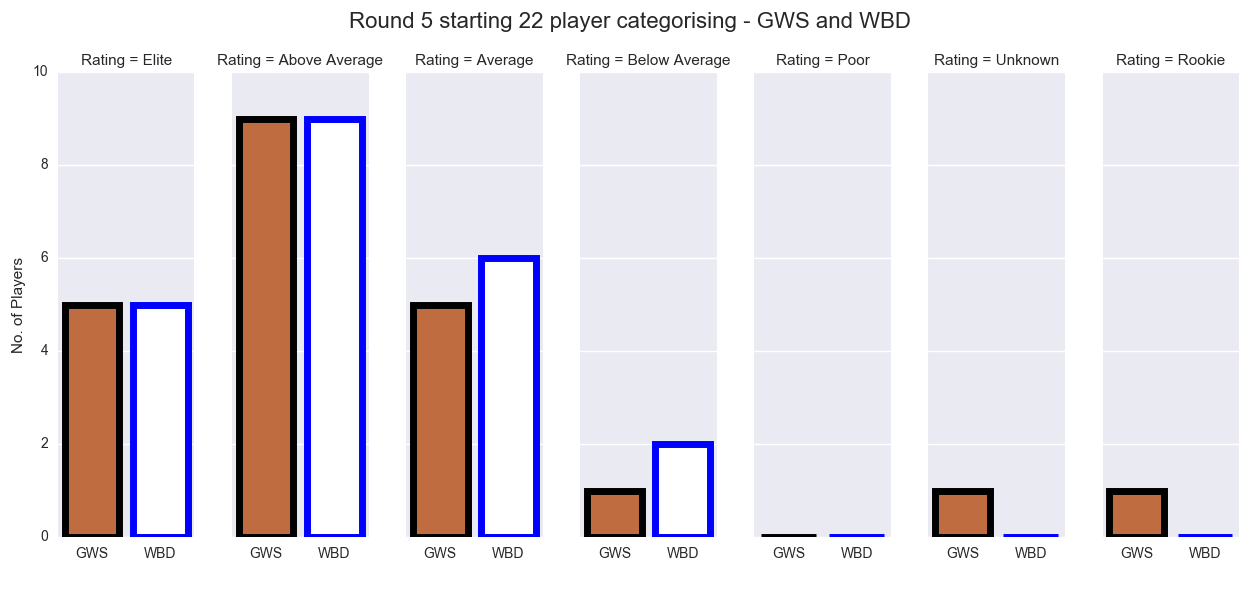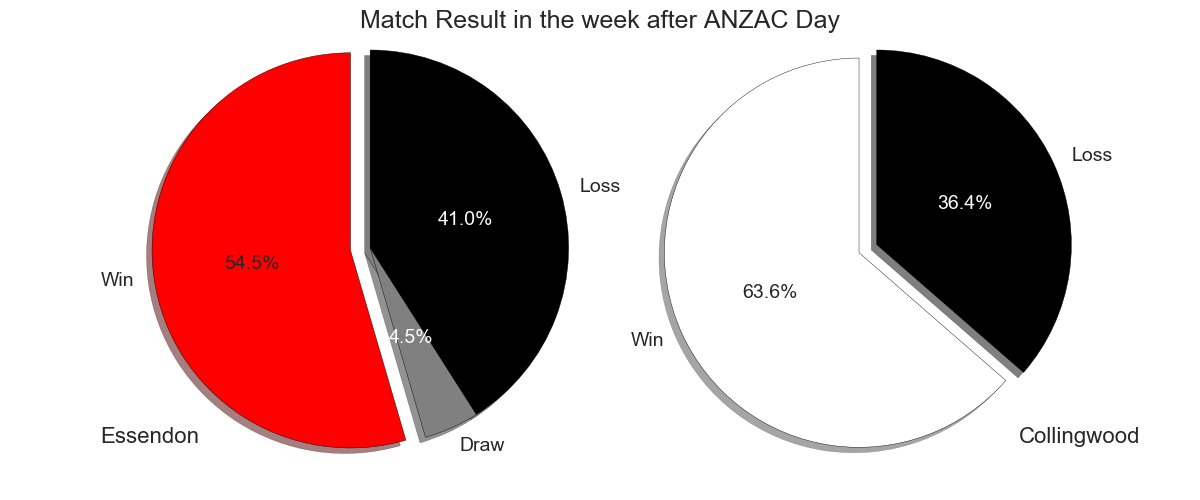AFL Round 6: GWS Giants vs. Western Bulldogs
Friday Night, 28th April 2017 at Manuka Oval
----------
… Johannisen, he’s a lively player, he can run, here he goes, caressing ball to Bontempelli, Bontempelli no-one between he and the goal, paddles it up, gets back onto his left foot, to hit the front, to hit the front, the dogs are in front by a point, Bontempelli has brought them to their feet.
Brian Taylor in commentary for Channel Seven
GWS Giants vs. Western Bulldogs, September 24th 2016
The defining moment of the season’s defining game. With the outpouring of emotion that came with winning the premiership 6 days later, the preliminary final will likely go down in history overshadowed by the events on Grand Final day. But the preliminary final was the better game.
The two players involved in the aforementioned passage of play, Marcus Bontempelli and Jason Johannisen, are symbolic of the rise of the Western Bulldogs over the past few years, from also-rans to premiership team.
Marcus Bontempelli was taken at No. 4 in the 2013 National Draft behind Tom Boyd, Josh Kelly and Jack Billings. The other players in the top 10 that year were Kade Kolodjashnij, Matthew Scharenberg, James Aish, Luke McDonald, Christian Salem and Nathan Freeman. Of that lot, the only player that looks like coming close to matching Bontempelli’s potential is Josh Kelly. So looking back on that draft, Bontempelli was an absolute steal at pick 4. But hindsight is a wonderful thing as at the time the view was rather different. The 2014 AFL Prospectus described the Bulldogs selection as follows:
They took the biggest risk of the top-10 selections taking Marcus Bontempelli with pick four. There is no doubting his ability, it’s just consistency that is the concern
Bontempelli arguably should have won the Rising Star Award in 2014 and only three years into his career he is already an elite player of the competition and one of the most damaging, a player who can impact a game without a large possession count (an absolute Supercoach darling).
Jason Johannisen was picked up in the 2010 Rookie Draft as an explosive line-breaking midfielder. In 2011 he played 15 games at VFL reserves level playing as a midfielder who could go forward. He switched to defense in 2012 and his good form in the VFL earned him his AFL debut late in the season and a post-season elevation to the primary list. He became a regular of the AFL side in 2013 before injury ended his season prematurely. He was in and out of the team in 2014 before finishing the season off in strong form. He carried that form into 2015, his breakthrough season, playing 20 games and becoming one of the most attacking defenders in the game. He then of course took his game to a whole new level in 2016, despite the hamstring injury that kept him out for 10 weeks, ending it on a high by winning the 2016 Norm Smith Medal.
Whether it is good recruitment or good coaching, the Bulldogs have done exceptionally well over the past few years from their investment in young players. There are countless other examples. Luke Dahlhaus and Lin Jong are other rookie list success stories (not to mention veterans Matthew Boyd, Dale Morris and Liam Picken who were all rookie elevations). Or Caleb Daniel, overlooked by many teams due to his size. Granted, the Bulldogs have been blessed with some good father-son recruits, Tom Liberatore, Lachie Hunter and Mitch Wallis, but they did still have to give up draft picks for them.
Similarly to the Bulldogs, GWS have invested in youth and the team they have put together now looks very ominous. The AFL have been accused of creating Frankenstein due to the generous draft concessions afforded the GWS to ensure their success. But they still needed to pick the right players, develop a culture and provide good coaching. The Gold Coast is an example of a team not getting it quite right. Regardless if good recruitment or good coaching has helped them, the Bulldogs and GWS are now seeing the rewards for investing in young talent. To understand how quickly fortunes can change for a club investing in youth, let’s look back to the start of the 2015 AFL season and assess the AFL landscape. The 2014 premiership season had finished with Hawthorn crushing Sydney in the Grand Final. Whilst at the other end of the table, only percentage separated St Kilda and Melbourne from winning the wooden spoon. For once it was a meaningless wooden spoon, as Melbourne would have likely selected Christian Petracca ahead of Paddy McCartin at No. 1 in the National Draft anyway. The Western Bulldogs had finished 14th with 7 wins and GWS had finished 16th with 6 wins. But in terms of experience on their list heading into the 2015 season, both teams were dead last. Table-1 presents the average games played by the players on the primary list of each team entering the 2015 season [1].
Table-1: 2015 List Assessment – Games
But the average games played for a team only partially tells the story, i.e. their level of experience or lack thereof. It is the average age of a team’s primary list that is a greater indicator of growth potential. Table-2 presents the average age of the players on the primary list of each team entering the 2015 season [1].
Table-2: 2015 List Assessment – Age
Obviously this metric does not indicate the quality of the players, and good development coaching is also required for the players to reach their full potential. However, it is interesting looking at the top of the list. Fremantle started 2015 on fire before falling to Hawthorn in a preliminary final at home. They then fell off a cliff in 2016, although injuries did cruel them. 2017 was heading the same way until they switched to youth in Round 3. North Melbourne won their first 9 games in 2016 before only winning 3 of their next 14 for the rest of the season, after which they offloaded their aging stars and have now started 2017 winless. Under the weight of the drugs scandal, 2015 was a disaster for Essendon and they eventually parted ways with James Hird. 2016 was the gap year when they lost all their star players to suspension providing them with the long-term benefit of blooding young players. Watching their performance on ANZAC Day earlier this week and the younger players in particular, their future looks bright. After their three-peat, Hawthorn were already on the downturn in 2016 and have fallen even further in 2017, starting the season with 4 poor losses. The Round 5 win has stemmed the tide of criticism temporarily. And Sydney although unlucky with injury are also winless in 2017 after being a grand finalist in 2016. Currently it’s Geelong as the team defying gravity. Although they did finish 10th in 2015 and then recruited one P. Dangerfield for the 2016 season.
So is football becoming a young man’s game? Table-3 presents the average age of the players on the primary list of each team entering the 2017 season. The best teams seem to have the balance between youth and experience, with premiership favourites Adelaide and GWS the best examples. Of most concern is probably West Coast and their ageing list. In particular most of their stars are well into the second half of their careers. Their premiership window is probably closing.
Table-3: 2017 List Assessment – Age
But returning to the fixture at hand. The 2016 finals series introduced us to GWS and the Western Bulldogs as the teams to watch for the seasons to come. But where are they both currently at in 2016? Taking form aside, let’s look at the quality of their current starting 22. Figure-1 presents both team’s starting 22 from Round 5 categorised based on their player classification in the 2017 AFL prospectus [2]. Although the player classifications are an indication of an individual’s qualities, strong team play can positively affect a players rating. So it is no surprise that both teams have a collection of highly rated players. Nevertheless, in terms of the quality of the current starting 22 it would appear that both teams are almost on a par. An indication that if both teams play to their potential we are in for a great game.
Figure-1: Round 5 starting 22 player categorising – GWS and WBD
----------
Tip: The Bulldogs have yet to be convincing this season, however they are getting the points on the board with 4 wins out of 5. Whilst GWS, after being humbled by the early season pacesetter in Adelaide in Round 1 have bullied their next 4 opponents into submission. Although it took them until the last quarter to shake off Port Adelaide at home, so they are still vulnerable to good opposition. So if the Bulldogs can return to the intensity of late 2016 they could trouble GWS. But at home in Canberra, I don’t think GWS will let the game slip like they did in that 2016 preliminary final, they will have a point to prove.
GWS to win by 21 points.
----------
Post Match Comments:
Final Score: GWS Giants 11.9.75, Western Bulldogs 9.19.73
Well it turns out the two teams were indeed very evenly matched. The two teams were comparable in almost every statistical category:
· Kicks: GWS 218, Bulldogs 203
· Handballs: GWS 163, Bulldogs 169
· Clearances: GWS 40, Bulldogs 38
· Contested Possessions: GWS 154, Bulldogs 158
· Tackles: GWS 74, Bulldogs 72
And as a re-match of the best game from 2016, it certainly delivered. The match comfortably sits as the benchmark game so far in 2017. And their rivals would certainly have noticed the intensity at the ball shown by both teams. September beckons again for both teams. Let the rivalry grow.
----------
[1] Champion Data. (2017). “AFL Prospectus 2017”, Glen Luff, Victoria, Australia
[2] Elite = Top 10% of position. Above Average = Top 35% of position. Average = Middle 30% of position. Below Average = Bottom 35% of position. Poor = Bottom 10% of position. Unknown = Played less than 10 games (2015-16). Rookie = Rookie listed player.






